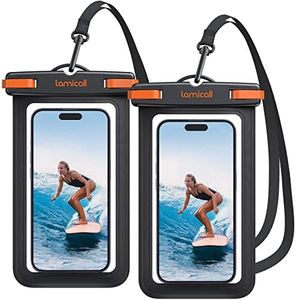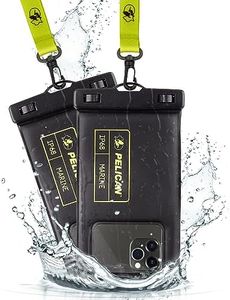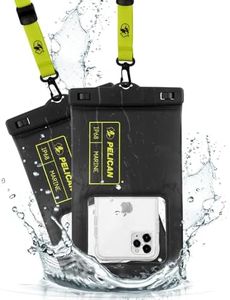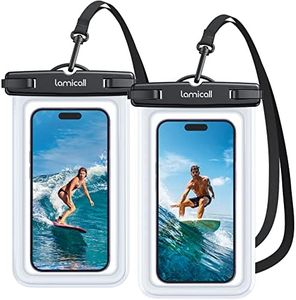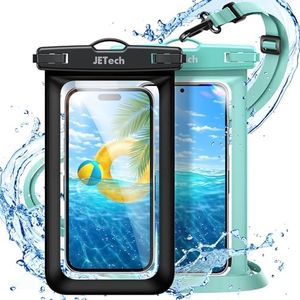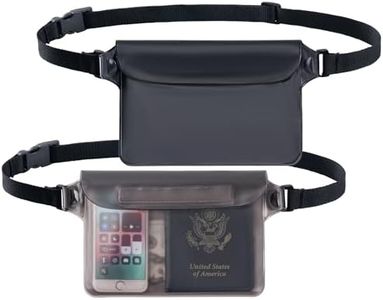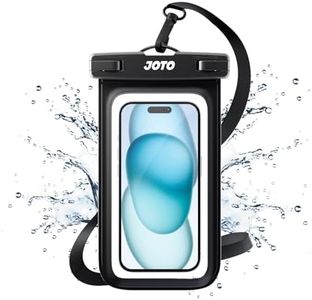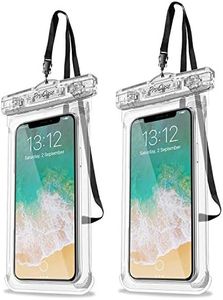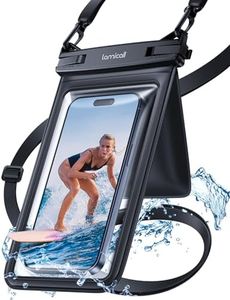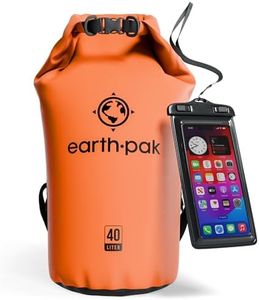We Use CookiesWe use cookies to enhance the security, performance,
functionality and for analytical and promotional activities. By continuing to browse this site you
are agreeing to our privacy policy
10 Best Waterproof Pouches
From leading brands and best sellers available on the web.By clicking on a link to a third party's website, log data is shared with that third party.
Buying Guide for the Best Waterproof Pouches
Choosing a waterproof pouch is all about ensuring your belongings—like phones, cards, and keys—stay dry and protected in wet environments, whether you're at the beach, by the pool, or out in the rain. The right pouch should fit your items well, guard against water, and suit your activity. Understanding the main features will help you make sure you get the best protection and convenience for your needs without worrying about leaks or damage.Waterproof Rating (IP Rating)The waterproof rating, often shown as an IP (Ingress Protection) code, tells you how well the pouch stops water and dust from getting inside. A higher IP number means better protection. The first digit is about solids like dust, but the second digit is about water. For example, IPX7 means it can handle being submerged in water briefly, while IPX8 is for longer submersion. If you just want to protect against rain or splashes, lower ratings are fine. For swimming or underwater activities, look for higher ratings like IPX8. Decide what type of water exposure your pouch will face and use that as your guide.
Closure TypeThe closure is how the pouch seals itself to keep out water—popular types include zip locks, twist-and-lock, or roll-tops with buckles. Some are easier and quicker to open while others might be more secure. Twist-and-lock and multiple zip locks tend to be more reliable for full waterproofing, great for swimming or heavy splashing. Roll-tops are excellent for larger pouches or bags and also provide a good seal. If you access your items often, balance between convenience and security. Think about where and how you’ll use it; for diving, choose the most secure, while for a rainy commute, quicker access might matter more.
Material QualityMaterials like PVC, TPU, or vinyl are common in waterproof pouches. Quality impacts how long the pouch lasts and how well it keeps water out. Thicker material gives better protection and resists tearing, especially if the pouch will get bumped or squished. Softer, flexible materials make it easier to use touchscreens inside the pouch. If you just want light water resistance for a day out, lighter material may be enough; for rugged use or adventurous trips, prioritize tougher, thicker material.
Size and FitSize determines what you can carry and how comfortable the pouch is to wear or store in a bag. Some pouches fit only small items, while others are large enough for tablets or documents. Make sure to measure your main items (like your phone) and check the provided size—internal dimensions matter most. Too big and your gear might move around, too small and it won’t fit at all. For daily carry, a snug fit for just essential items is perfect; for travel or adventure, bigger sizes might make sense.
Transparency and FunctionalityMany waterproof pouches are see-through so you can use your phone’s screen or camera while it stays protected. Some allow touch interaction, calling, or photography underwater. If you want to use your device in the pouch, look for clear, sensitive panels. If you just need to store items and won’t use the screen, then this isn’t as important. Think about whether you'll need access to your phone’s features or just general protection.
Carrying OptionsHow you carry the pouch can make a big difference. Options include neck straps, waist belts, or clips to attach to a bag or belt. A neck strap is convenient for swimming or beach activities, while a waist belt is good for running or water sports. Clips are handy for attaching to backpacks on hikes or rides. Choose a carrying method that fits how you plan to use the pouch—comfort and security can make it much more enjoyable and practical.
